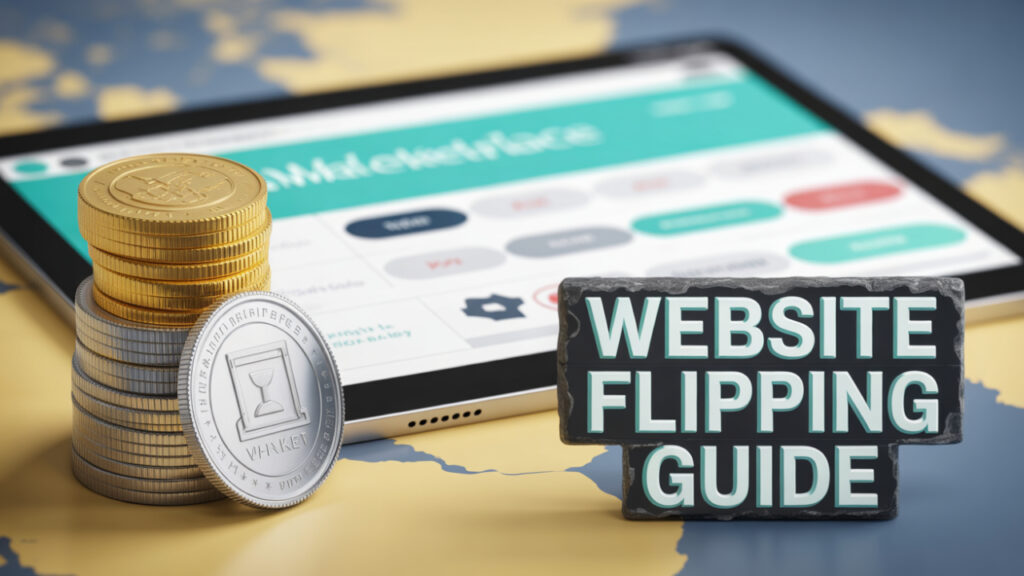Website flipping is one of the most lucrative digital investment strategies in today’s online business world. Just like real estate flipping, this process involves buying undervalued websites, enhancing them to increase revenue and performance, and then selling them at a profit. With relatively low entry barriers and growing market demand, flipping websites can be an excellent side hustle or even a full-time business.
This step-by-step guide to flipping websites for profit will walk you through the essentials of finding profitable sites, improving them strategically, and making successful sales.
What is Website Flipping?
Website flipping is the process of buying existing websites, improving their performance (through SEO, design, monetization, etc.), and selling them for more than the purchase price. Investors and digital entrepreneurs are increasingly drawn to this model because of the flexibility and scalability it offers.
“Website flipping is the new digital real estate. It allows you to buy low, add value, and sell high – all from your laptop.” – Digital Entrepreneur’s Digest
Why Flip Websites for Profit?
Here’s why many people are getting into the business of flipping websites:
- Low startup costs: You don’t need a lot of capital to start.
- Scalable: You can flip one site or dozens.
- Skill development: You’ll gain skills in SEO, content creation, marketing, and analytics.
- Recurring income: Many sites earn money while you own them.
Step-by-step guide to flipping websites for profit
Let’s break down the process into actionable steps:
Step 1: Learn the Market and Choose Your Niche
Before you buy anything, familiarize yourself with the market. Understand which niches are in demand and what types of websites are selling well on platforms like:
Niche Examples:
- Affiliate marketing
- Content blogs
- E-commerce (Shopify or WooCommerce)
- SaaS or tool-based platforms
Step 2: Find and Buy a Website
Once you’ve chosen a niche, search for underperforming but promising websites. Look for:
- Consistent traffic
- Some form of revenue (ads, affiliate, digital products)
- Low-quality design or content (which you can improve)
- Poor SEO structure
Key Metrics to Check Before Buying:
| Monthly Visitors | 1,000+ |
| Domain Authority | 10+ |
| Monthly Revenue | $100-$1,000 (starter) |
| Age of Website | 6 months or older |
Step 3: Improve the Website
This is where value is added. Your goal is to make the site more attractive to potential buyers by increasing performance.
Areas to Improve:
- Content Optimization
- Add new articles and optimize existing ones with keywords.
- Ensure proper formatting and internal linking.
- SEO Enhancement
- Improve meta titles and descriptions.
- Build high-quality backlinks.
- Fix broken links and increase page speed.
- Monetization
- Add or optimize AdSense, affiliate links, or digital product offerings.
- Design and UX
- Use clean, responsive themes.
- Improve navigation and mobile compatibility.
Step 4: Track and Grow Performance
Don’t sell too early. Take a few months to improve metrics like:
- Traffic
- Revenue
- Engagement (bounce rate, time on site)
Use tools like Google Analytics, Ahrefs, and SEMrush to monitor performance and growth.
Step 5: Sell the Website
Once the site shows improved performance and earnings, list it on a marketplace.
Top Selling Platforms:
Prepare the site for sale with:
- Clean financial statements
- Performance screenshots
- Domain and hosting access
- Monetization proofs
Pro Tip: Most sites sell for 20-40x of monthly profit. A site earning $300/month might sell for $6,000-$12,000.
How Much Profit Can You Make?
Your profit depends on your buying price, how much you improve the site, and market conditions. Here’s an example:
| Purchase Price | $1,500 |
| Revenue (6 mo) | $300/month |
| Total Revenue | $1,800 |
| Selling Price | $6,000 |
| Profit | $6,300 |
This includes earnings during the improvement phase + sale profit.
Tools You’ll Need for Flipping Websites
Equip yourself with tools to make flipping easier and more professional:
| Keyword Research | Ubersuggest, Ahrefs, SEMrush |
| SEO Audit | Screaming Frog, SEO Site Checkup |
| Content Creation | Grammarly, Jasper, Surfer SEO |
| Site Monitoring | Google Analytics, Search Console |
| Monetization | AdSense, Amazon Affiliates, Gumroad |
Common Mistakes to Avoid
Before you get started, avoid these common pitfalls:
- Buying a site without revenue or traffic history
- Neglecting due diligence on backlinks (check for spammy links)
- Overpaying based on seller claims
- Ignoring monetization opportunities during improvement
- Not documenting changes, making it hard to prove value-added
Final Thoughts
Flipping websites for profit is a powerful way to build digital income. With the right strategy and tools, even beginners can generate substantial returns in just a few months. Whether you’re in it for quick flips or long-term passive income, this business model offers versatility, growth potential, and a fast track to online success.
FAQ Section
Q1: How much money do I need to start flipping websites? A1: You can start with as little as $500-$1,000 for small content sites. However, more established sites may cost several thousand dollars.
Q2: How long should I hold onto a website before selling? A2: Ideally, 3-6 months. This allows you time to improve content, SEO, and monetization for a higher resale value.
Q3: Do I need technical skills to flip websites? A3: Basic skills in WordPress, SEO, and content marketing help. You can outsource technical tasks like design or development.
Q5: Where can I learn more about flipping websites? A5: You can explore in-depth guides and communities at:


